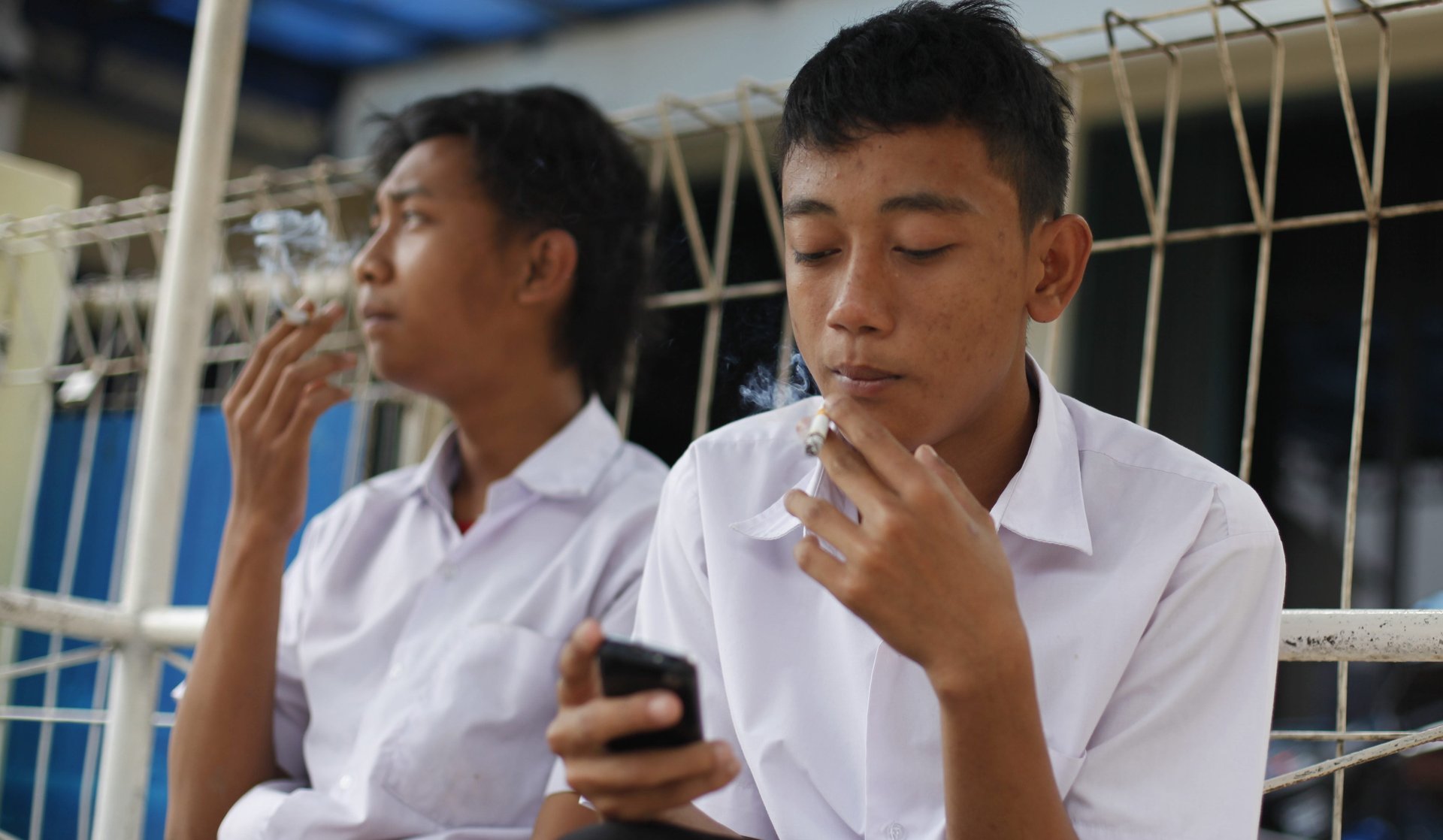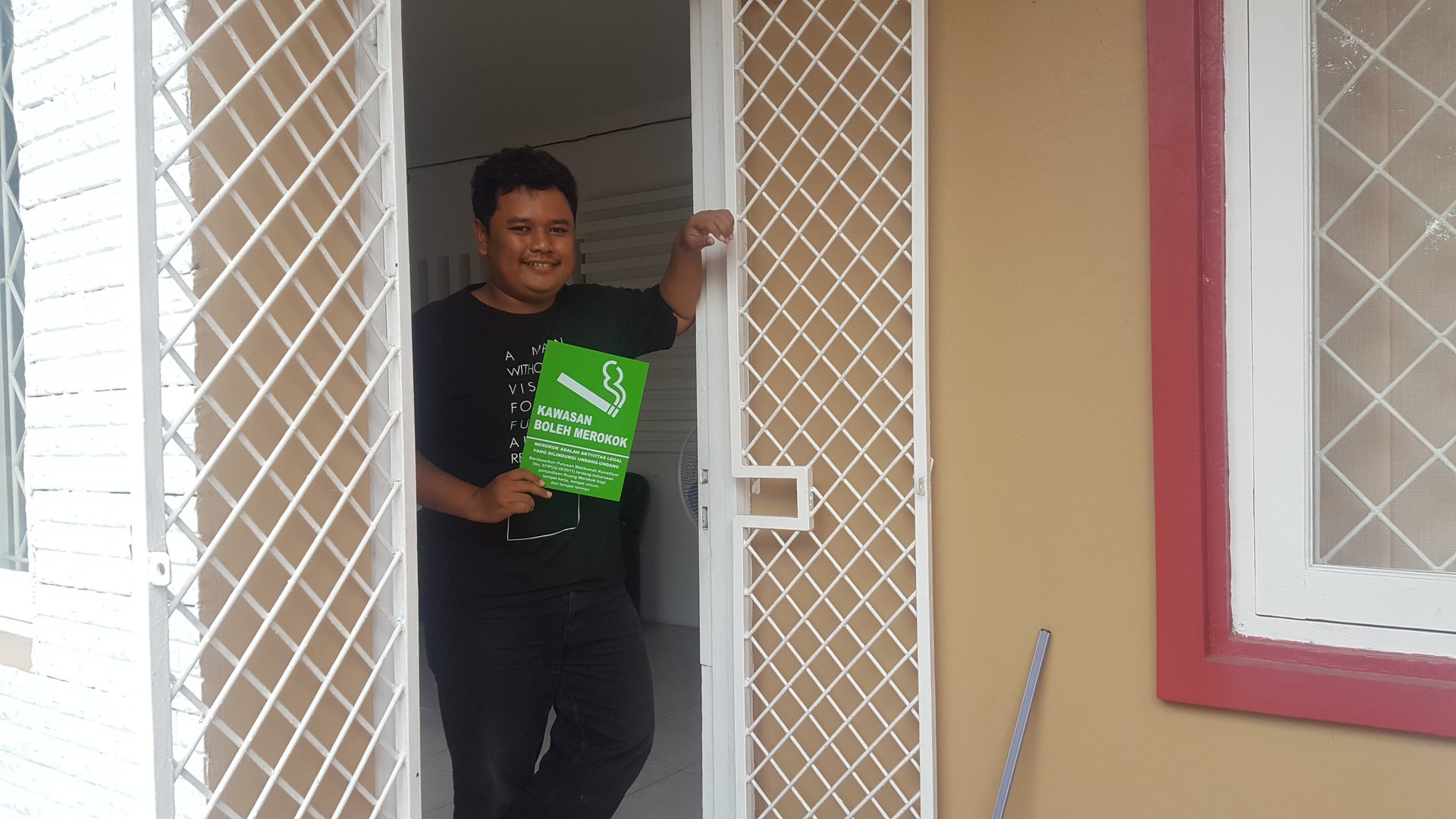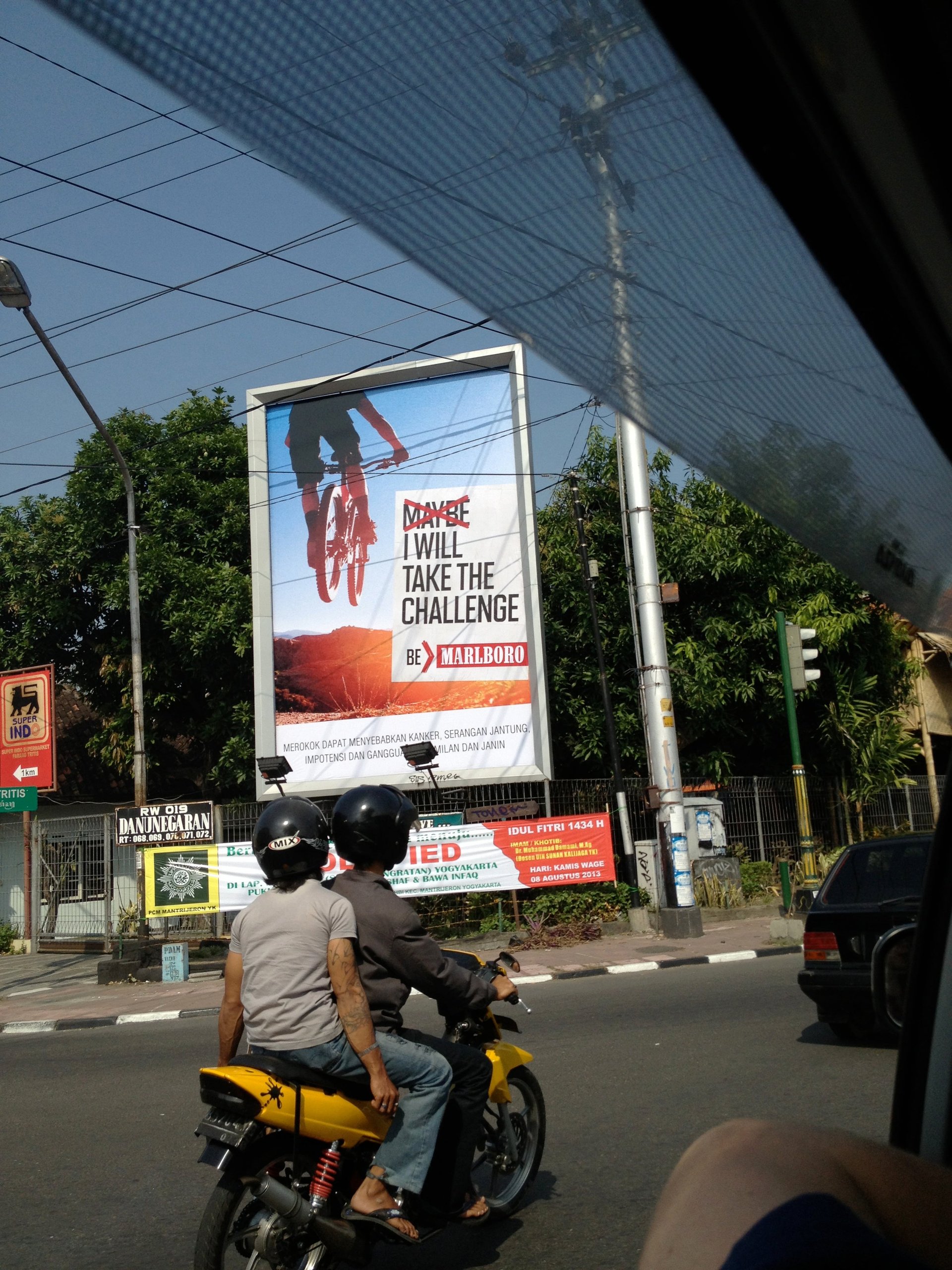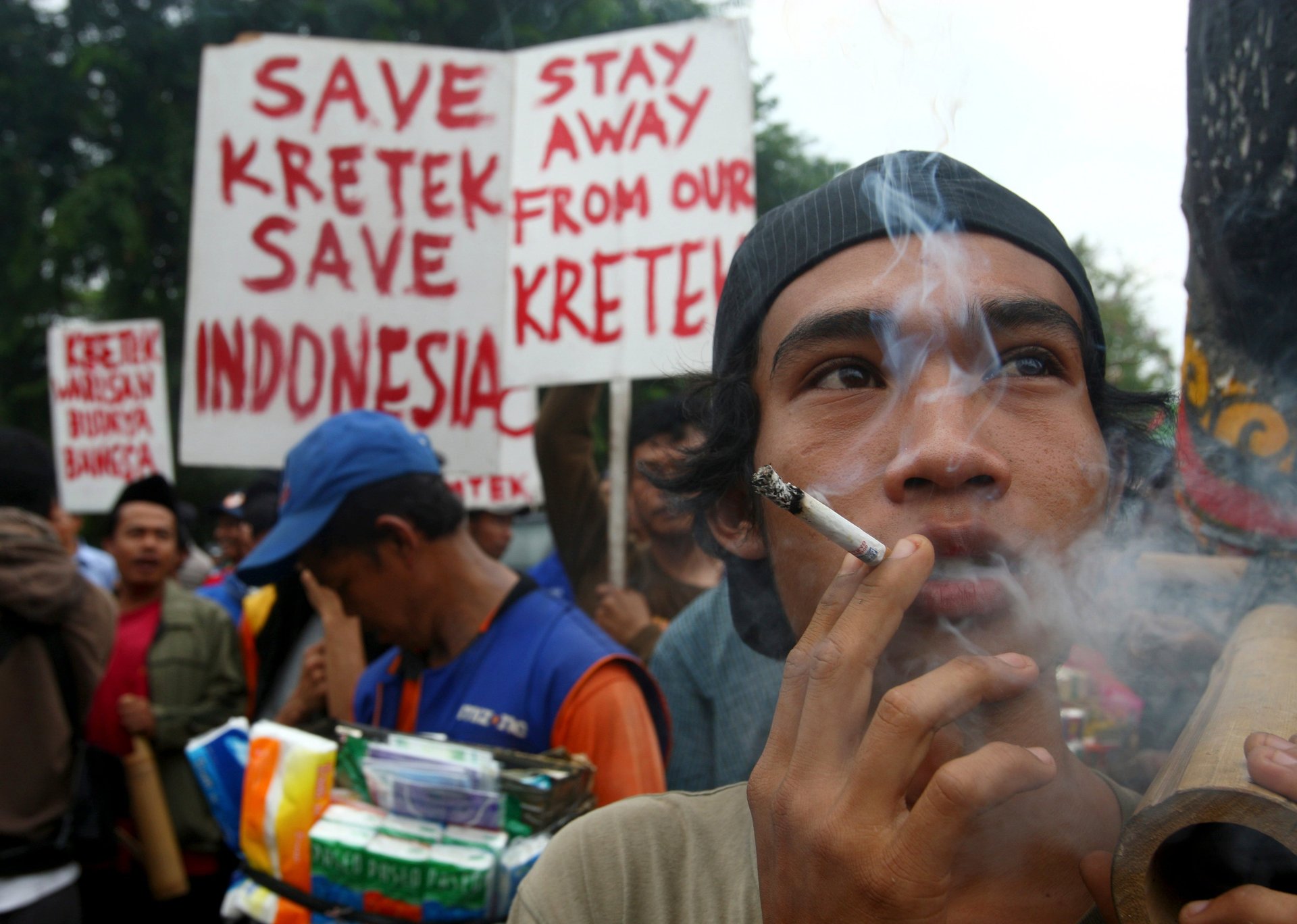In Marlboro’s last frontier, a smokers’ rights group is defending the “human right” to light up
Jakarta, Indonesia


Jakarta, Indonesia
“A man without a vision always falls for his past,” reads Aditia Purnomo’s t-shirt, as he sits in his office west of Jakarta.
At 25, he is the chain-smoking head of the Indonesian smokers’ rights group Komunitas Kretek, and he has one message for “anti-smoking fundamentalists” from the West: butt out.

His organization, which doubles as a trade promotion group for the local cigarette industry, makes its aim clear on its website: “To uphold the independence of the nation against foreign threats to the local commodity.”
And it has some ideas that would be controversial, to say the least, in the West. Among them is that smoking kretek, a local type of clove cigarette, is “not addictive,” can help treat asthma, and even cures bad breath.
It also lists some novel, and not so novel, reasons against tobacco regulation: It will damage the advertising industry, people on scholarships from tobacco companies will lose out, and nicotine is found in vegetables that we eat, so it must be fine in cigarettes.
And the push for stricter tobacco regulation is all part of a culture war from the West, according to Purnomo, who had his first cigarette at 12.
One of his organization’s key activities is visiting cafés and reminding people of the their “constitutionally mandated right to smoke.”
“Smoking is a legal activity which is protected by the law!” reads one of the signs given to cafés to display.
“It is a human right to smoke. Smokers feel like they don’t have their rights anymore,” he says. “We need to stand up for our rights!”
Marlboro Country’s last frontier
Few smells are as ubiquitous in Jakarta as that emitted by the popular kretek cigarette. Named after the crackling of the burning cloves found within, its soft-smelling smoke—banned in the US—can be found in cafés, markets, and offices across the archipelago.
Regarded by many as a symbol of national pride, almost 90% of those who light up in Indonesia prefer kretek. “Loosies,” or single cigarettes, can be picked up for just a few cents and are often sold in stalls set up outside schools.

Even the Marlboro man, literally dead in the West, is miraculously alive and well in Indonesia. Billboards plastered above the country’s notorious traffic urge motorists to “Take the lead” and “Don’t be a maybe.”
In the only Asian country yet to ban tobacco advertising, companies here have almost free rein to peddle their wares.
Ben Weir, an Australian visiting Indonesia, says he has twice been approached to appear in commercials for cigarettes.
“They wanted to hire a foreigner to appeal to the middle-class males,” says Wier, who declined the offers. “They wanted the ad to look like a Calvin Klein shoot and show me throwing darts at a board in a club.”
Even China, long considered one of the most smoker-friendly nations, has banned tobacco advertising in mass media. Indonesia is now on track to displace China as home to the largest population of smokers over the next decade.
In Indonesia, 70 million people out of a population of 250 million are smokers, and cigarette consumption is rising faster (pdf) here than anywhere else in the world. Up to 400,000 people a year die from smoking-related illnesses in the country.
Despite warnings of an impending “tobacco holocaust”—and a cost to the economy of $7 billion dollars, or 2.4% of its GDP (pdf, p29)—the Indonesian government is still among a handful of nations, along with Somalia, Malawi, and Zimbabwe, that has yet to ratify the World Health Organization’s Framework Convention on Tobacco Control.
Conversely, the Industry Ministry announced in 2015 it plans to double (paywall) cigarette production to 524.2 billion cigarettes per year by 2020. And so cigarette advertising, marked by the mildest of warnings, continues to assault consumers across Indonesia.
Industry interference is driving the worrying figures, says Mary Assunta, senior policy advisor for the Southeast Asia Tobacco Control Alliance (SEACTA). Tobacco companies not only have cozy relationships with governments at all levels of Indonesian politics—from the national right down to local districts—but are also asked for input before new regulations are created. Research from SEACTA shows (pdf, p6) Indonesia has the highest levels of interference with, as well as participation in, policy development by the tobacco industry in Southeast Asia.
“The industry and its representatives push boundaries and arguments not seen in other countries,” she says. “[For] tobacco companies Indonesia is one of the most important cigarette markets for profit growth.”
“The tobacco industry’s Disneyland”
In Jakarta’s southeast sits Sampoerna Academy, part of the philanthropic arm of the Indonesian tobacco giant Sampoerna, owned by Philip Morris International.
While such a sight would be rare in the West, in Indonesia—which has been described as “the tobacco industry’s Disneyland“—everything from badminton matches to music festivals are sponsored by tobacco companies.
And it is no accident either, according to Mark Hurley, the Indonesian director at the Campaign for Tobacco-Free Kids.
“These tactics are used by international giants like Philip Morris and Indonesian brands alike because tobacco companies rely on luring in youth to replace those who die or quit smoking,” he says. “It’s part of their deadly playbook.”
A survey conducted in 2016 found 85% of schools surveyed in five Indonesian cities were surrounded by tobacco advertisements. And according to Purnomo from the smokers’ rights group, their campaigns appear to be working.
Experts say the tobacco companies’ corporate social responsibility programs are merely a strategy to further entrench their products into society and do little social good. “Through their CSR activities, the Indonesian tobacco companies have precisely ignored the negative impacts of tobacco,” said a recent report from the Online Journal of Health Ethics.
It is tobacco’s entrenched status in Indonesian society that makes fighting tobacco so difficult for campaigners, who are often labelled agents of US pharma giants trying to bring down Indonesia’s sovereignty.
One example is a book provided by Komunitas Kretek, Nicotine War: Nicotine and the Drug Dealer, which argues that behind the global agenda on tobacco control are major trading business interests pushing nicotine-replacement therapy.
“While the anti-tobacco people are busy campaigning about the the dangers of tobacco and continue to push the government to regulate and control tobacco,” the book’s blurb reads, “international corporations that profit from the tobacco business are busy counting and searching for opportunities to gain more profit from the nicotine business.”

Any efforts to develop policy to regulate tobacco is portrayed as “foreign interference,” according to Assunta. “It’s a tragedy for smokers’ rights groups to continue to deny the evidence, and mislead the public and government,” she adds.
“The whole damn city smokes”
But it’s not all bad news. While there is no national “smoke-free law” in Indonesia, some local governments are leading the charge.
Ten years ago, Indonesia had very few cities requiring smoke-free spaces. Today, more than 170 cities have passed laws restricting smoking in public spaces.
Another example is a local community in Yogyakarta in central Java, which painted anti-tobacco murals to “subvert” the actions of Philip Morris International after it gained international notoriety in 2015 by painting a village as part of a marketing campaign.
Still, Philip Morris International remains confident about Indonesia. The company’s 2016 investor day presentation (pdf) said Indonesia shows “favourable market demographics over the long term.” Another slide was titled, “Indonesia: Positives results from recent new launches.”
It seems the tobacco industry is counting on Jakartans like 19-year-old Ayu (who like many Indonesians goes by one name), who says she is too addicted to quit and will continue to smoke despite the harms.
“My friends all smoke, my colleagues all smoke. The whole damn city smokes,” she says. “How am I ever going to quit?”